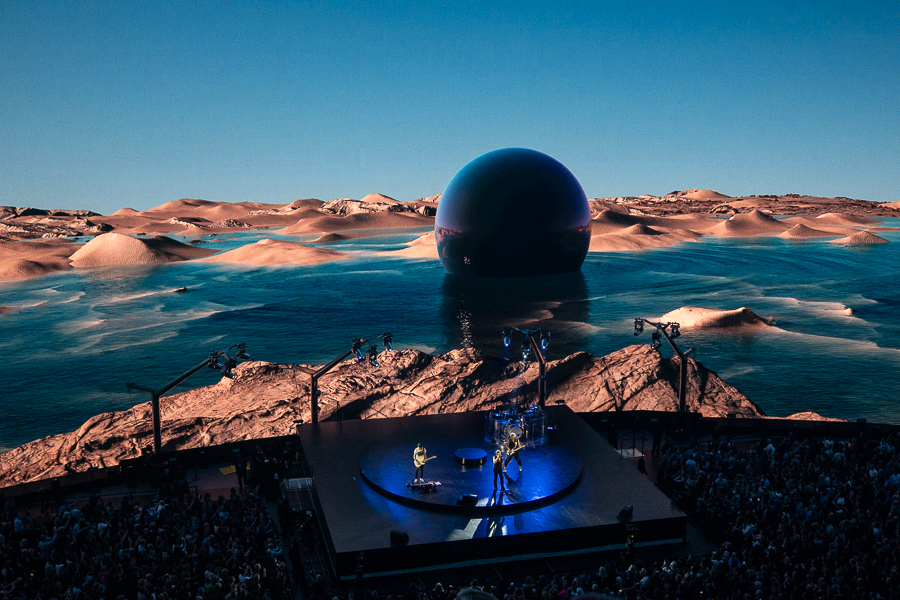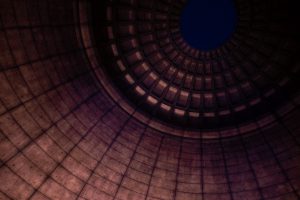Opinion: The astounding potential of Las Vegas’ Sphere

U2 performs at Sphere in Las Vegas on Feb. 7, 2024. Steve Carlson/STAFF.
A lot has been said about Sphere in Las Vegas being game-changing for concerts, and it’s all true. The technology that went into this insane $2.3-billion building is as mind-boggling as you’ve heard. It completely changes what’s possible for live music, both visually and aurally. It’s like nothing else.
I debated whether it made sense to travel to Las Vegas to see U2’s multi-monthlong Sphere residency, right up until a few days before I left, but ultimately I knew I had to go see it for myself. I’m so glad I did. The show was inspiring and beautiful, and the band (sans Larry Mullen Jr., who is recovering from surgery related to his lifetime of drumming) was in top form. Bono’s voice sounded far better than it had on their previous few tours. And they were celebrating the 30th anniversary of my favorite U2 album, Achtung Baby, by playing the whole album, which made it extra special for me.
I did the best I could to document the show with my iPhone and a pocket camera they allowed in. But there’s just no way to capture how enormous and immersive and realistic that screen is with just a basic camera. I made a few panoramas, but they still don’t give a proper sense of scale, or a sense of how the screens mess with your brain. When I first entered the auditorium, an usher warned me not to look up until I reached my seat. It was good advice, because once I looked up at the Romanesque dome being rendered above my head, I got a little dizzy. If I didn’t know it was a giant TV, I would’ve thought the walls were truly made of concrete. The resolution and dynamic range is that good. In case it didn’t feel real enough, they even had a little computer-generated bird fly into the dome at one point and perch in the alcoves high above our heads!

U2 performs during the opening night of its U2:UV Live at Sphere residency in Las Vegas on Sept. 29, 2023. Photo: Rich Fury.
The magic of Sphere is that the video screen is so seamless, and so high resolution, they can create all sorts of illusions that seem impossible, like making the spherical room appear cubed, or giving the impression that it has limitless height, or that you’re actually outdoors. It’s freaky at times.
The sound is equally impressive. It’s surround sound, like a movie theater but multiplied by a thousand. It’s said to boast 167,000 individual drivers hidden behind the video wall that can be beam-formed to send completely different sounds to different parts of the room. The acoustics are fantastic, and the sound is crystal clear. It envelops you. Primary instruments were centered up front as usual, but they moved many of the atmospheric parts into the surround channels, wrapping themselves around you just as the video does to your eyes. At moments they would pan sounds around the room, even moving The Edge’s guitar solo into the ceiling when they know the audience is going to be looking straight up at a video effect. It never feels gimmicky, and it’s revolutionary for live music. This kind of stuff just can’t be done in an arena or stadium.
I think U2 was only scratching the surface of what’s possible with their use of the technology, as they’ve said they wanted to keep it a proper rock show. Aside from a few choice moments, most of the video was relatively restrained and meant to be a feast for the eyes rather than a nausea-inducing mind trip. Many of the visuals felt reassuringly natural and realistic: deserts, oceans, lightning storms, starry nights, cityscapes and bugs (maybe too many bugs). Aside from a few well-timed vibrations from the haptic seats, there was no noticeable use of the other “4D” capabilities of Sphere, such as wind or scents. I expect other artists will push the limits further, and it’ll be interesting to see how audiences handle what their production designers will dream up.
Who will follow U2 at Sphere? There is probably a short list of artists in the world who would take full advantage of the building’s capabilities, while also capable of luring 20,000 fans to the desert each night for enough nights to justify the production costs for such a unique venue. So far the only two residencies that have been announced are jam bands: Phish plays a short series of shows in late April, followed by Grateful Dead offshoot Dead & Company, which returns from the grave to headline a series of weekend shows from late May through July. Both bands have passionate, well-traveled fan bases and seem well suited to take advantage of the space with incredible, mind-bending visuals and immersive sound. But beyond that, it’s anyone’s guess.
Follow photographer Steve Carlson at Instagram.com/SteveCarlsonSF and Twitter.com/SteveCarlsonSF.


